Why do spots appear on gooseberry leaves
White, yellow, brown, black, red and even purple - whatever spots are found on gooseberry bushes. They are small, the size of a pea, or occupy the entire leaf plate. Spots signal the presence of diseases or insects that can destroy the entire crop and infect nearby crops. The article will tell you why gooseberry leaves curl and spots appear and how to recognize diseases by signs.
The content of the article
Gooseberry leaf diseases
Gooseberries get sick for various reasons. Some plants lack light and warmth, others suffer from waterlogging or lack of nutrients in the soil. Sometimes the symptoms of the disease are immediately noticeable, sometimes they are difficult to see with the naked eye.
Spots on the leaves

Spots are a sign of many diseases... For example, when infected with anthracnose, brownish-brown spots with a diameter of about 1 cm appear on the leaves, which increase in size over time. The spots merge with each other, the leaves dry and soon fall off.
The causative agent of anthracnose is a marsupial mushroom that actively spreads in hot and humid weather... The first signs of anthracnose are observed at the end of the flowering phase, around May-June. Also, the disease occurs due to improper care: due to excessive watering, an excess or lack of mineral and organic substances.
Spots on the leaves are also a sign of septoria, or white spot. The lesions are gray-white and have a clear outline. If you do not take steps to treat the gooseberry, the leaves curl and fall off. Diseased branches give a weak growth, the commercial qualities and taste of gooseberries deteriorate. In the meantime, small black dots are formed on the spots. Warm weather contributes to the development of white spot, so the disease is more common in the southern regions. Septoria also occurs due to the weak immunity of the variety, thickened plantings.
Curling and curling of leaves
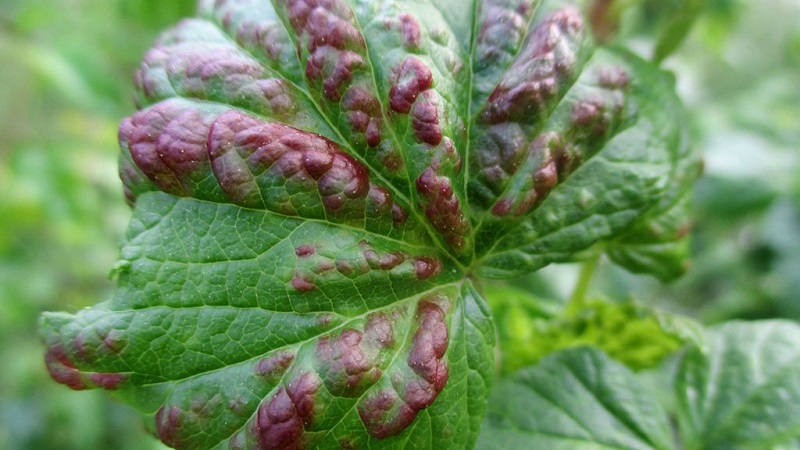
Why do the leaves fold? Powdery mildew is a common cause of this. A common disease affects young and old shrubs. At the beginning of infection, all parts of the plant are covered with a white bloom, which eventually turns dark brown.
The leaves become brittle and curl, and the berries stop growing and fall off. If you don't take action, the gooseberries will die. Spores of fungi - pathogens of powdery mildew are easily spread by wind or insects, they overwinter on plant debris and are resistant to heat. The causes of infection are unhealthy seedlings, dirty garden tools, diseased plants in the neighborhood.
Interesting! Leaves curl up as a result of being hit by a spider mite or gooseberry shoot aphid. The plates deform, dry out and fold. Insect pests hibernate in the soil, actively manifest themselves in the spring, when warm weather sets in. The length of insects is about 0.2 mm - to detect their clusters, it is recommended to regularly examine the leaves from the inside and outside.
Curliness of leaves is a sign of terry (reversion)... The disease is viral and cannot be treated. Pathogens are transmitted through ticks and live on plant cuttings. If a reversion is detected, the infected shrubs are removed from the site and burned, and the remaining plants are disinfected with a solution of Bordeaux liquid.
Bronze shade
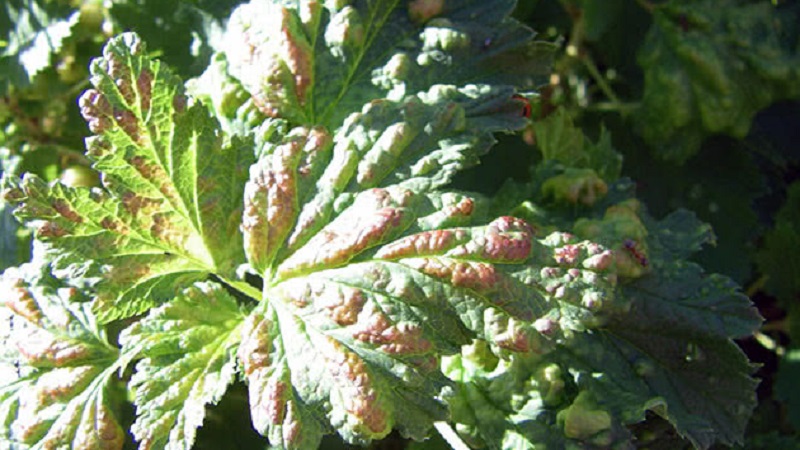
A bronze tint on the leaves appears due to goblet rust - a fungal disease. Dark spots with an orange tint appear on the plates, yellow spore pads are visible.
Spores of the fungus are carried by winds and rain, the disease arises from weeds and thickened plantings. The rapid spread of the disease is facilitated by sharp weather changes and high humidity. Goblet rust can destroy up to 80% of the crop, so it is important to detect its symptoms in time and start treating shrubs.
Blackheads and plaque
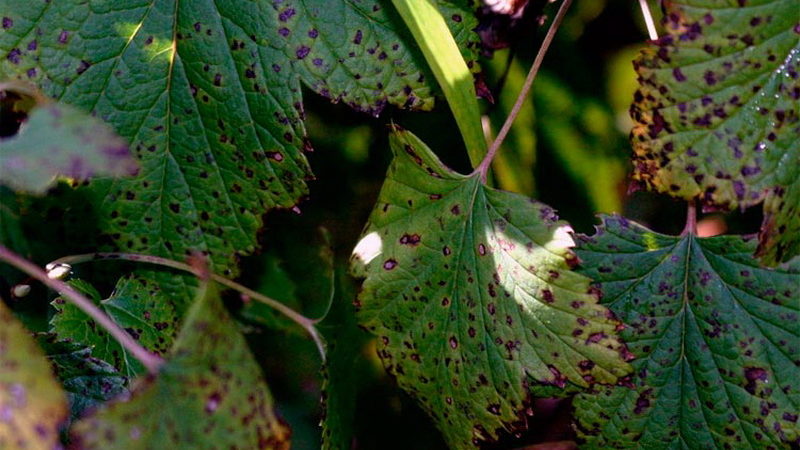
Black dots appear due to scab. The disease is widespread in all regions of Russia, it affects shrubs of any age. It appears due to the close occurrence of groundwater, growing bushes in lowlands, an overabundance of nitrogen-containing fertilizers. First, a light loose bloom appears on the leaves, and after black dots - mushroom fruiting bodies. The spots expand, the leaves fall off. If a dense brown film has formed, it means that the disease is progressing and it is more and more difficult to save the gooseberry every day.
Black plaque arises from the spheroteca - a marsupial fungus, the causative agent of American powdery mildew. Together with the leaves, the ends of the shoots and fruits turn black and dry. Adult plants are particularly affected. Favorable conditions for the spread of the disease are soil with an excess of nitrogen-containing fertilizers.
Purple and red leaves
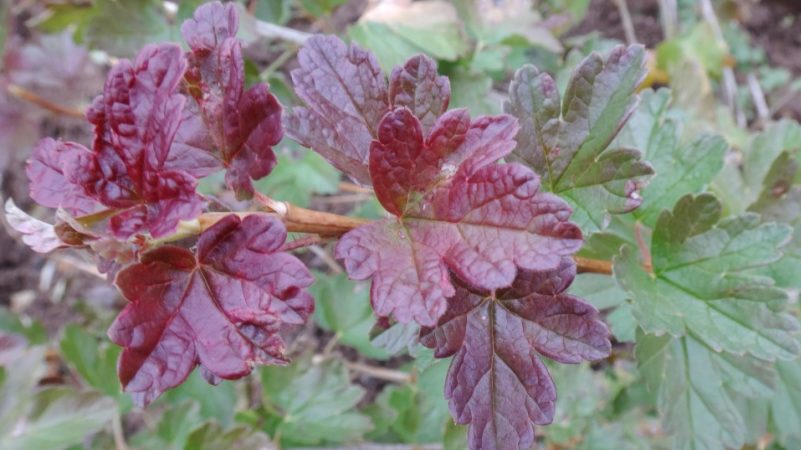
The leaves get a purple hue not due to illness, but due to a lack of minerals - phosphorus and potassium. The lower parts of the shoots and petioles change color, stop growing. To eliminate the deficit, mineral complex fertilizers are applied. At the same time, they monitor watering, regularly loosen and mulch the soil.
In addition to purple, red is also found on the bushes. Gooseberry leaves turn red due to a lack of iron or boron. They solve the problem by adding top dressing: 20 g of ferrous sulfate are diluted in 10 liters of water. Plants are sprayed with the solution, and after 3-5 days the redness subsides.
Yellow leaves
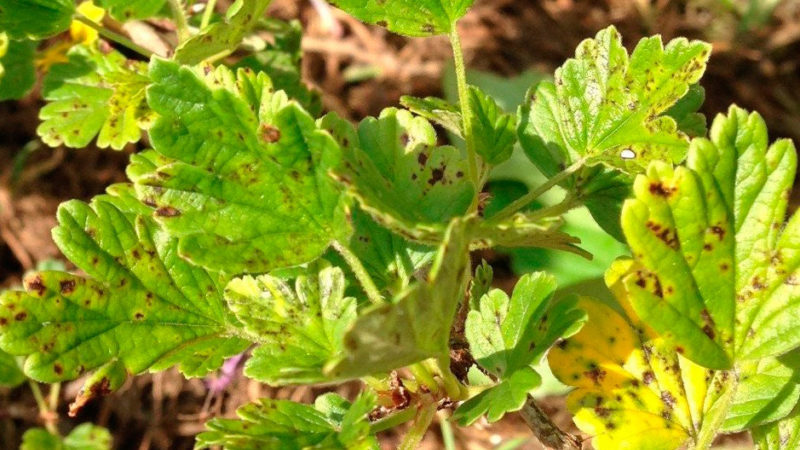
Yellow leaves - signal about the appearance of a mosaic. Yellow patterns appear on the affected bush, which over time turn the leaves wrinkled and dry. The viral disease is spread by pests, mainly aphids and spider mites.
Interesting! In addition to stains or plaque, mold also appears on the gooseberry: white, yellow, gray, brown. The reasons for its appearance are a damp growing place, an excess of dressings, a thickened planting. They get rid of the problem with the help of ash infusion: for 12 liters of water, 1 kg of dry ash and 500 ml of liquid soap. The solution is insisted for 3 days, filtered and watered with gooseberries.
The mosaic appears if you do not hold an annual sanitary pruning of shrubs, do not remove dry and old shoots. The disease reduces crop yield, quickly spreads to neighboring plants.
How to process bushes
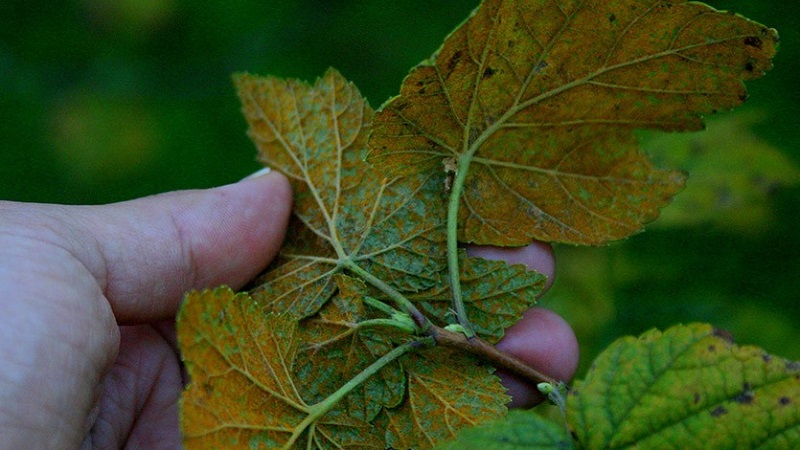
To avoid the appearance of diseases, experienced summer residents recommend paying attention to preventive measures.
These procedures include:
- disinfection of seedlings and cuttings;
- planting gooseberries in a clean area without last year's plant residues and weeds;
- disinfection of garden tools before procedures;
- keeping the distance when landing;
- regular spraying with a solution of Bordeaux liquid or folk remedies;
- inspection of shrubs;
- collection and removal of fallen leaves;
- maintaining the cleanliness of the beds.
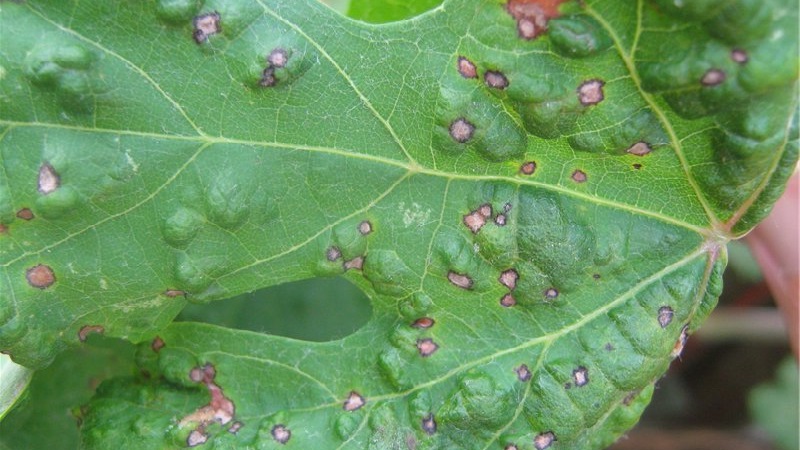
The systemic fungicide Topaz is used to treat viral and fungal diseases. It is suitable for the treatment of all varieties of gooseberries, has a flexible application time and a long-lasting effect. To prepare the working solution, use 10 l of water and 2 ml of the drug. Gooseberries are sprayed with a spray bottle in dry weather, morning or evening. "Topaz" is used against powdery mildew, rust, anthracnose and white spot.
To get rid of insect pests use "Tanrek": it destroys adults and larvae.The product does not wash off by rain and does not lend itself to high temperatures, destroys aphids and spider mites. Pests die within 2-3 hours. After 2-3 days, the effect of the procedure is fixed with an infusion of garlic (for 10 liters of water, 300 g of peeled garlic). The solution is mixed and filtered, used for spraying.
Against bacterial diseases use a 1% solution of Bordeaux liquid... Cooking requires 10 liters of water, 100 g of copper sulfate and 100 g of quicklime. The ingredients are mixed, spraying is carried out every 2-4 weeks during the entire growing season.
Conclusion
Light leaves on gooseberries signal powdery mildew infection, red or purple spots - about a lack of mineral elements, yellow patterns - about mosaics.
In order for the gooseberry to grow healthy and bear fruit stably, it is recommended to treat it with antimicrobial agents and examine it for external signs of infection. When twisting the leaves, the shrub is sprayed with a solution of copper sulfate or Bordeaux liquid, when spots appear - with an ash solution or Topaz fungicide.